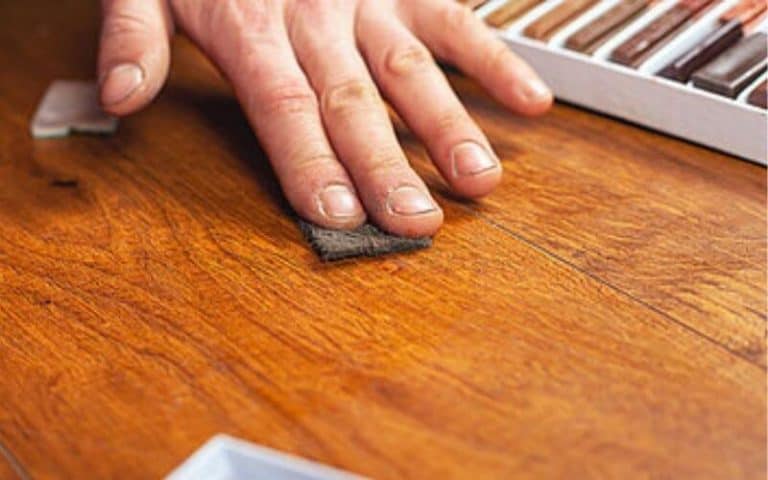The elegance and classic charm of wood furniture can bring a touch of warmth and sophistication to any home or office space. However, accidents happen, and sometimes our beloved wooden treasures suffer from unsightly nicks, scratches, or even chips. These blemishes can not only diminish the aesthetic appeal of the furniture but also affect its structural integrity if left unattended. Fortunately, repairing chip wood is not a herculean task and can be tackled with the right materials, techniques, and a little patience. In this comprehensive guide, we will delve into the realm of chip wood repair, unraveling the secrets to restoring your cherished wooden possessions to their former glory.

Image: floorcarekits.com
Understanding Chip Wood and Its Causes
Chip wood refers to a localized area of damage to the surface of wooden furniture caused by impact or pressure. The severity of the chip can range from minor surface imperfections to more substantial chunks of wood being gouged out. While accidents can happen anytime, there are certain factors that increase the susceptibility of wood to chipping, such as:
• Type of Wood: The density and grain pattern of different wood species influence their resistance to chipping. Softer woods, such as pine, are more prone to chipping compared to harder woods like oak.
• Age of the Wood: As wood ages, it naturally becomes more brittle and susceptible to damage, making older furniture more vulnerable to chipping.
• Improper Handling: Rough handling or dropping wooden furniture can result in chips and dents.
Materials Required for Chip Wood Repair
Gathering the necessary materials before embarking on the repair process is crucial for success. Here’s a checklist of items you’ll need:
• Wood filler: This comes in various formulations, such as epoxy, vinyl, or acrylic-based. Choose a filler that matches the species and color of the wood you’re repairing.
• Putty knife: This tool is used to apply and smooth the wood filler.
• Sandpaper: In varying grits (coarse, medium, fine) for shaping and smoothing the repaired area.
• Tack cloth: To remove debris and prepare the surface for finishing.
• Stain or paint (optional): If the repaired area needs to be colored or stained to match the surrounding wood.
Step-by-Step Chip Wood Repair Guide
Now that you have the necessary materials, let’s walk through the step-by-step process of repairing chip wood:

Image: johnnycounterfit.com
1. Preparation
Clean the damaged area with a tack cloth to remove any dust or debris. If the chip is particularly deep, you may need to use a small chisel or a knife to gently widen the opening to ensure the wood filler can penetrate and adhere properly.
2. Applying Wood Filler
Using the putty knife, apply the wood filler into the chip, ensuring it fills the entire cavity without overflowing. Smooth the surface of the filler to match the surrounding wood. If the chip is large or requires multiple applications of filler, allow each layer to dry completely before applying the next.
3. Sanding
Once the filler has dried, use sandpaper to sand the repaired area. Start with a coarse grit sandpaper to remove any excess filler and shape the patch. Gradually progress to finer grits to smooth out the surface. Sand in the direction of the wood grain for best results.
4. Staining or Painting (Optional)
If necessary, use stain or paint to match the color of the repaired area to the surrounding wood. Allow the stain or paint to dry completely before using the furniture.
Additional Tips for Effective Chip Wood Repair
• For deeper chips, consider reinforcing the repair with a small piece of wood glued underneath the damaged area before applying wood filler.
• If the chip has damaged the wood grain, use a wood graining tool or a fine-tipped marker to mimic the pattern of the surrounding wood.
• Practice your repair technique on a scrap piece of wood to get the hang of it before tackling the actual damaged area.
• Allow ample time for the wood filler to dry completely before sanding or staining.
• Use a light touch when sanding to avoid gouging the surrounding wood.
• If you’re not confident about repairing the chip wood yourself, don’t hesitate to consult a professional furniture repair specialist.
How To Fix Chip Wood
Conclusion
By following the steps outlined in this guide and employing the recommended techniques, you can effectively repair chip wood and restore your cherished wooden furniture to its former glory. Remember, patience and attention to detail are key to achieving a seamless and professional-looking repair. Whether it’s a beloved heirloom or a recently acquired piece, restoring chip wood not only enhances its aesthetic appeal but also preserves its value and extends its lifespan. Embrace the challenge, and let the satisfaction of a successful repair add to the story of your cherished wooden possessions.